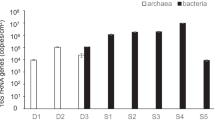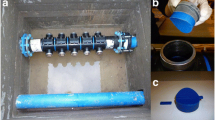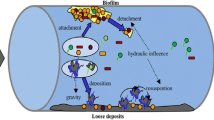Abstract
Biofilms inhabiting pipeline walls are critical to drinking water quality and safety. With massive pipeline replacement underway, however, biofilm formation process in newly built pipes and its effects on water quality are unclear. Moreover, differences and connections between biofilms in newly built and old pipes are unknown. In this study, early succession (≤ 120 days) of biofilm bacterial communities (abundance and diversity) in upper, middle and bottom areas of a newly built cement-lined ductile iron pipeline were evaluated using improved Propella™ biofilm reactor and multi-area analysis. A comparison with old pipelines (grey cast iron, 10 years) was performed. In the newly built pipeline, the abundance of biofilm bacteria did not change significantly between 40 and 80 days, but increased significantly between 80 and 120 days. The biofilm bacterial abundance (per unit area) in the bottom area was always higher than that in the upper and middle areas. Based on alpha diversity index and PCoA results, biofilm bacterial community richness, diversity and composition did not change significantly during the 120-day operation. Besides, biofilm shedding from the walls of newly built pipeline significantly increased bacterial abundance in the outlet water. Opportunistic pathogen-containing genera, such as Burkholderia, Acinetobacter and Legionella, were identified in both water and biofilm samples from newly built pipelines. The comparison between new and old pipelines suggested a higher bacterial abundance per unit area at the middle and bottom areas in old pipelines. Moreover, the bacterial community composition of biofilms in old pipelines was similar to that of newly built pipelines. These results contribute to accurate prediction and management of biofilm microbial communities in drinking water pipelines, ensuring the biosafety of drinking water.
Key Points
• Biofilm bacterial communities in different areas of pipe wall were revealed.
• The abundance of biofilm bacteria increased significantly between 80 and 120 days.
• Biofilm bacterial community compositions of newly built and old pipes were similar.
Graphical Abstract










Similar content being viewed by others
Data availability
All data of this study are included in this published article and its supplementary information files.
References
APHA (2012) Standard Methods for the Examination of Water and Wastewater, twenty-second ed. American Public Health Association, Washington, DC, New York
Bolton N, Critchley M, Fabien R, Cromar N, Fallowfield H (2010) Microbially influenced corrosion of galvanized steel pipes in aerobic water systems. J Appl Microbiol 109(1):239–247
Cruz MC, Woo Y, Flemmming HC, Wuertz S (2020) Nitrifying niche differentiation in biofilms from full-scale chloraminated drinking water distribution system. Water Res 176:115738
Dong XW (2000) Anticorrosive technology for cement mortar lined pipeline. Oil-Gasfield Surface Eng 19(3):43–44
Edgar RC (2013) UPARSE: highly accurate OTU sequences from microbial amplicon reads. Nat Methods 10(10):996–998
Fish K, Osborn AM, Boxall JB (2017) Biofilm structures (EPS and bacterial communities) in drinking water distribution systems are conditioned by hydraulics and influence discolouration. Sci Total Environ 593–594:571–580
Flemming HC, Wingender J (2010) The biofilm matrix. Nat Rev Microbiol 8(9):623–633
Flemming HC, Percival SL, Walker JT (2002) Contamination potential of biofilms in water distribution systems. Wa Sci Technol 2(1):271–280
Folkman S (2012) Water main break rates in the USA and Canada: a comprehensive study. Utah State University Buried Structures Laboratory Report
Gomes IB, Simoes M, Simoes LC (2014) An overview on the reactors to study drinking water biofilms. Water Res 62:63–87
Gomez-Alvarez V, Pfaller S, Pressman JG, Wahman DG, Revetta RP (2016) Resilience of microbial communities in a simulated drinking water distribution system subjected to disturbances: role of conditionally rare taxa and potential implications for antibiotic-resistant bacteria. Environ Sci-Wat Res 2(4):645–657
Gomez-Smith CK, Lapara TM, Hozalski RM (2015) Sulfate reducing bacteria and mycobacteria dominate the biofilm communities in a chloraminated drinking water distribution system. Environ Sci Technol 49(14):8432–8440
Guo H (2016) Research on electrochemical corrosion mechanisms of water supply pipes. Dissertation, Tian** University
Han ZM, An W, Yang M, Zhang Y (2020) Assessing the impact of source water on tap water bacterial communities in 46 drinking water supply systems in China. Water Res 172:115469
Hemdan BA, El-Taweel GE, Goswami P, Pant D, Sevda S (2021) The role of biofilm in the development and dissemination of ubiquitous pathogens in drinking water distribution systems: an overview of surveillance, outbreaks, and prevention. J Microbiol Biotechn 37(2):36
Kitajima M, Cruz MC, Williams RBH, Wuertz S, Whittle AJ (2021) Microbial abundance and community composition in biofilms on in-pipe sensors in a drinking water distribution system. Sci Total Environ 766:142314
Learbuch KLG, Smidt H, van der Wielen PWJJ (2021) Influence of pipe materials on the microbial community in unchlorinated drinking water and biofilm. Water Res 194(18):116922
Lehtola MJ, Torvinen E, Kusnetsov J, Pitkänen T, Maunula L, von Bonsdorff CH, Martikainen PJ, Wilks SA, Keevil CW, Miettinen IT (2007) Survival of Mycobacterium avium, Legionella pneumophila, Escherichia coli, and Caliciviruses in drinking water-associated biofilms grown under high-shear turbulent flow. Appl Environ Microb 73(9):2854–2859
Li Q, Yu SL, Li L, Liu GC, Gu ZY, Liu MM, Liu ZY, Ye YB, **a Q, Ren LM (2017) Microbial communities shaped by treatment processes in a drinking water treatment plant and their contribution and threat to drinking water safety. Front Microbiol 8:2465
Liu G, Bakker GL, Li S, Vreeburg JHG, Verberk JQJC, Medema GJ, Liu WT, Van Dijk JC (2014) Pyrosequencing reveals bacterial communities in unchlorinated drinking water distribution system: An integral study of bulk water, suspended solids, loose deposits, and pipe wall biofilm. Environ Sci Technol 48(10):5467–5476
Liu JQ, Chen HY, Huang Q, Lou LP, Hu BL, Endalkachew SD, Mallikarjuna N, Shan YG, Zhou XY (2016a) Characteristics of pipe-scale in the pipes of an urban drinking water distribution system in eastern China. Water Sci Tech-W Sup 16(3):715–726
Liu S, Gunawan C, Barraud N, Rice SA, Harry EJ, Amal R (2016b) Understanding, monitoring, and controlling biofilm growth in drinking water distribution systems. Environ Sci Technol 50(17):8954–8976
Liu G, Tao Y, Zhang Y, Lut M, Knibbe WJ, van der Wielen P, Liu W, Medema G, van der Meer W (2017a) Hotspots for selected metal elements and microbes accumulation and the corresponding water quality deterioration potential in an unchlorinated drinking water distribution system. Water Res 124:435–445
Liu JQ, Ren HX, Ye XB, Wang W, Liu Y, Lou LP, Cheng DQ, He XF, Zhou XY, Qiu SD, Fu LS, Hu BL (2017b) Bacterial community radial-spatial distribution in biofilms along pipe wall in chlorinated drinking water distribution system of East China. Appl Microbiol Biot 101(2):749–759
Liu XX, Tian ZJ, Hu X, Zhang YB, Qiao Y, Cao Y, Huang L (2017c) Isolation, identification and degradation characteristics of a phenanthrene-degrading strain. Acta Scientiarum Nat Univ Nankaiensis 3:49–53
Liu G, Zhang Y, Liu XL, Hammes F, Liu WT, Medema G, Wessels P, van der Meer W (2020) 360-Degree distribution of biofilm quantity and community in an operational unchlorinated drinking water distribution pipe. Environ Sci Technol 54(9):5619–5628
Ma X, Zhang GM, Li GW, Wan YJ, Sun HF, Wang HB, Shi BY (2018) Biofilm bacterial community transition under water supply quality changes in drinking water distribution systems. Environ Sci-Wat Res 4(5):644–653
Makris KC, Andra SS, Botsaris G (2014) Pipe scales and biofilms in drinking-water distribution systems: undermining finished water quality. Crit Rev Env Sci Tec 44(13):1477–1523
Manuel CM, Nunes OC, Melo LF (2007) Dynamics of drinking water biofilm in flow/non-flow conditions. Water Res 41(3):551–562
Martin M (2011) Cutadapt removes adapter sequences from high-throughput sequencing reads. Embnet J 17(1):10–12
Mi ZL, Dai Y, **e SG, Chen C, Zhang XJ (2015) Impact of disinfection on drinking water biofilm bacterial community. J Environ Sci 37(11):200–205
Ostojcic M, Budzaki S, Flanjak I, Rajs BB, Barisic I, Tran NN, Hessel V, Strelec I (2021) Production of biodiesel by Burkholderia cepacia lipase as a function of process parameters. Biotechnol Progr 37(2):e3109
Pintar KDM, Slawson RM (2003) Effect of temperature and disinfection strategies on ammonia-oxidizing bacteria in a bench-scale drinking water distribution system. Water Res 37(8):1805–1817
Prest EI, Hammes F, van Loosdrecht MCM, Vrouwenvelder JS (2016) Biological stability of drinking water: controlling factors, methods, and challenges. Front Microbiol 7(45):1–24
Qureshi N, Shah J (2014) Aging infrastructure and decreasing demand: A dilemma for water utilities. J Am Water Works Ass 106(1):51–61
Schloss PD, Westcott SL, Ryabin T, Hall JR, Hartmann M, Hollister EB, Lesniewski RA, Oakley BB, Parks DH, Robinson CJ, Sahl JW, Stres B, Thallinger GG, Van Horn DJ, Weber CF (2009) Introducing mothur: open-source, platform-independent, community-supported software for describing and comparing microbial communities. Appl Environ Microb 75(23):7537–7541
Schmieder R, Edwards R (2011) Quality control and preprocessing of metagenomic datasets. Bioinform 27(6):863–864
Shen Y, Huang CH, Lin J, Wu WJ, Ashbolt NJ, Liu WT, Nguyen TH (2017) Effect of disinfectant exposure on Legionella pneumophila associated with simulated drinking water biofilms: release, inactivation, and infectivity. Environ Sci Technol 51(4):2087–2095
Shi Y, Babatunde A, Bockelmann-Evans B, Li QJ, Zhang L (2020) On-going nitrification in chloraminated drinking water distribution system (DWDS) is conditioned by hydraulics and disinfection strategies. J Environ Sci 96:151–162
Waak MB, Hozalski RM, Hallé C, LaPara TM (2019) Comparison of the microbiomes of two drinking water distribution systems - with and without residual chloramine disinfection. Microbiome 7(1):87
Wang Q, Garrity GM, Tiedje JM, Cole JR (2007) Naive Bayesian classifier for rapid assignment of rRNA sequences into the new bacterial taxonomy. Appl Environ Microb 73(16):5261–5267
Wang H, Masters S, Edwards MA, Falkinham JO, Pruden A (2014) Effect of disinfectant, water age, and pipe materials on bacterial and eukaryotic community structure in drinking water biofilm. Environ Sci Technol 48(3):1426–1435
Wilczak A, Jacangelo JG, Marcinko JP, Odell LH, Kirmeyer GJ (1996) Occurrence of nitrification in chloraminated distribution systems. J Am Water Works Ass 88(7):74–85
Zhang JJ, Kobert K, Flouri T, Stamatakis A (2014) PEAR: a fast and accurate Illumina Paired-End reAd mergeR. Bioinform 30(5):614–620
Zhang KJ, Cao C, Zhou XY, Zheng FF, Sun YM, Cai ZQ, Fu J (2018) Pilot investigation on formation of 2,4,6-trichloroanisole via microbial O-methylation of 2,4,6-trichlorophenol in drinking water distribution system: An insight into microbial mechanism. Water Res 131(15):11–21
Zhang ML, Wang L, Xu MY, Zhou H, Wang SL, Wang YJ, Bai M, Zhang C (2019) Selective antibiotic resistance genes in multiphase samples during biofilm growth in a simulated drinking water distribution system: Occurrence, correlation and low-pressure ultraviolet removal. Sci Total Environ 649:146–155
Zhou XY, Zhang KJ, Zhang TQ, Li C, Mao XW (2017) An ignored and potential source of taste and odor (T&O) issues-biofilms in drinking water distribution system (DWDS). Appl Microbiol Biot 101(9):3537–3550
Zhou XY, Zhang KJ, Zhang TQ, Yang YL, Ye MM, Pan RJ (2019) Formation of odorant haloanisoles and variation of microorganisms during microbial O-methylation in annular reactors equipped with different coupon materials. Sci Total Environ 679:1–11
Zhou CS, Wu JW, Dong LL, Liu BF, **ng DF, Yang SS, Wu XK, Wang Q, Fan JN, Feng LP, Cao GL (2020) Removal of antibiotic resistant bacteria and antibiotic resistance genes in wastewater effluent by UV-activated persulfate. J Hazard Mater 388:122070
Funding
This study was supported by the National Natural Science Foundation of China [grant number 52000032]; Fuzhou Water Supply Co., Ltd. and Fuzhou Water Quality Monitoring Co., Ltd. [grant number GY-H-21258]; the Research Start-up Funds of Fujian University of Technology [grant number GY-Z17075]; and the Research Funds of **jiang Fuzhou University Science Park [grant number 2019-JJFDKY-07].
Author information
Authors and Affiliations
Contributions
XC conceived, designed and performed research, and wrote the paper. LX performed research, contributed new methods, analyzed data, and wrote the paper. JN conceived, designed and performed research, contributed new methods, and wrote the paper. YW and XZ analyzed data. LG conceived research. FY performed research and analyzed data. KX conceived research and wrote the paper. All authors read and approved the manuscript.
Corresponding author
Ethics declarations
Ethics approval
This article does not contain any studies with human participants or animals performed by any of the authors.
Conflict of interest
The authors declare no competing interests.
Additional information
Publisher's note
Springer Nature remains neutral with regard to jurisdictional claims in published maps and institutional affiliations.
Supplementary Information
Below is the link to the electronic supplementary material.
Rights and permissions
Springer Nature or its licensor (e.g. a society or other partner) holds exclusive rights to this article under a publishing agreement with the author(s) or other rightsholder(s); author self-archiving of the accepted manuscript version of this article is solely governed by the terms of such publishing agreement and applicable law.
About this article
Cite this article
Chen, X., **ao, L., Niu, J. et al. Early succession of biofilm bacterial communities in newly built drinking water pipelines via multi-area analysis. Appl Microbiol Biotechnol 107, 3817–3828 (2023). https://doi.org/10.1007/s00253-023-12517-0
Received:
Revised:
Accepted:
Published:
Issue Date:
DOI: https://doi.org/10.1007/s00253-023-12517-0




